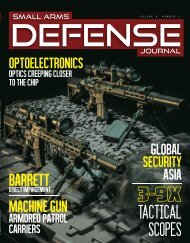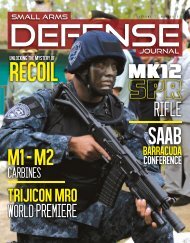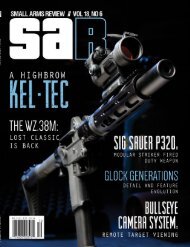SAR 20#2
You also want an ePaper? Increase the reach of your titles
YUMPU automatically turns print PDFs into web optimized ePapers that Google loves.
a qualifier of excellence or superiority- unless superiority<br />
can indeed be found in uniformity and consistency. The<br />
term “mil-spec” has become a generic descriptor, and is<br />
often applied to any of the wares and materials purveyed<br />
by today’s arms makers. And it is not entirely incorrect to<br />
refer to a steel alloy applied or used per an established<br />
mil-spec as “ordnance steel.” It is widely agreed that ordnance,<br />
or mil-spec steel refers to a specific family of steel<br />
alloy; chrome-moly, such as 4140. The enforcement of<br />
standards and uniformity is absolutely necessary to ensure<br />
any amount of quality and reliability in any system.<br />
Today all metal alloys are given a title or numerical designation<br />
from one of the authorities on metallurgy and engineering,<br />
the SAE, and AISI. These material names and<br />
designations describe a recipe or physical and chemical<br />
properties. So a steel may be described by what it actually<br />
is, as is the case with 4140CM steel, the 4 digit label<br />
indicates general type of alloy, and the precise levels of<br />
other additive elements to make the steel.<br />
In actual terms, depending on the manufacturer of a<br />
gun or its components, the terms Mil spec and Ordnance<br />
Steel may be used to describe any of the following (but<br />
not limited to); 4130, 4140, 4145, 4150, 4320, or 4340<br />
chrome moly alloys. The truth of the fact is that ANY steel<br />
may fall into the category of being “mil-Spec” provided<br />
that it satisfies the criteria set forth in the military standard<br />
for operating and yield strength for a specific application.<br />
There is a tendency for gun manufacturers to use misleading<br />
descriptions of their steel and its capabilities in<br />
order to promote sales. All steels are not created equal.<br />
This sales tactic can put the gun and its user at risk. All<br />
steels are not created equal; beware of the fly-by-night<br />
startup gun company that professes tactical supremacy<br />
but omits the metallurgical details of their operation. That<br />
said, modern firearms components from reputable sources<br />
(as are most things engineered) are designed with a<br />
“safety factor” in mind. Any gun barrel today should be<br />
designed with a minimum 1.5 safety factor- which means<br />
that barrel is designed to endure 1.5 times its intended<br />
operating load before failure or fatigue. The “mil-spec” for<br />
a steel structure usually demands a factor of only 1.5.<br />
Commercial engineering often requires a safety factor<br />
of 2.0 or higher. One should also be wary of the claim<br />
of “aerospace” in firearms design. The tolerance, safety<br />
factor and quality assurance by aerospace standards all<br />
become prohibitively expensive and ultimately restrictive<br />
to the end user. Aerospace grade demands a total detailed<br />
and documented control and trace of material from<br />
creation through use and operation. Nothing about your<br />
rifle is aerospace grade.<br />
On to the specifics of the steel that may be encountered<br />
in the modern small-arm. There are only 4 general<br />
types of steel; carbon, tool, alloy, and stainless. All material<br />
that can be described as steel is one of these. The<br />
creators of steel add various trace elements to iron to<br />
achieve desired properties. All steel contains between<br />
.25% and 2.5% carbon, which allows the base iron to be<br />
chemically or thermally manipulated with or without the<br />
addition of other alloying elements. To earn the rank of<br />
stainless, the recipe of that steel must contain at least<br />
11% chromium. Chrome moly alloy steel does contain<br />
chromium, but not enough to be stainless. And all stainless<br />
steel is not totally rust resistant. Some stainless is<br />
highly magnetic. It is doubtful that one will encounter a<br />
low carbon or plain carbon steel on a gun today; industry<br />
lawyers and a general concern for safety have well<br />
established a minimum for safety standards. Tool steel<br />
is capable of being very hard and tough, but is more difficult<br />
to craft. It may be used on guns in small amounts<br />
to form items like trigger parts or lock components. One<br />
<strong>SAR</strong> Vol. 20, No. 2 82 MARCH 2016









